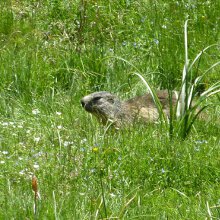Pyrenees Mammals
Mammals of the Pyrenees
The Pyrenees are home to a variety of mammals, with many native species unique to the Pyrenees. The Pyrenees are home to the Pyrenean Desman (Galemys pyrenaicus), Pyrenean Chamois (Rupicapra pyrenaica pyrenaica) and Pyrenean Brown Bear (Ursus arctos).
The best way to spot these animals in the mountains is on one of our walking holidays. Although your chances of seeing a bear or desman are very small, we often spot isard up on the steep mountain slopes, and Marmot and Griffon vultures are a common sight in the cirque de Troumouse on our Explorer walks. As part of your guided MountainBug holiday, your guide will show you as much as they can of the local wildlife, sharing their passion for the Pyrenees.
Below are brief descriptions of some of the mammals to be found in the Pyrenees. We are gradually building up a library of descriptions and photographs, but currently this list is not extensive.
Pyrenean Chamois, Rupicapra pyrenaica pyrenaica, or “isard”
The isard is the Pyrenees’ emblem. You may see it on signs to denote national park boundaries (a red isard’s head on a white background).
The Pyrenean chamois weighs between 25-35 kg, stands 70-80 cm at the shoulder, and can reach 110-135 cm in length.
Its body is a chestnut colour, with pale underparts and a white tail. A dark brown band runs from each side of its muzzle to its ears and eyes. The rest of its head and throat are white. It has narrow, curved horns, which rise directly above the head then hook sharply back at the tips.
The female is smaller than the male, but also has horns. The isard’s hooves are excellent for gripping slippery rock, and at the sign of danger, the isard hisses and stamps its feet to warn others.
This Pyrenean chamois likes altitude and steep slopes, and you can see them bouncing across rocky ledges, or dashing up near-vertical cliffs.
In 1967 there were only 1300 left but today there are over 5000. They live in herds of up to 100.
Alpine Marmot, Marmota marmot
The Marmot disappeared from the Pyrenees after the last glacial era, but they’ve now been successfully reintroduced.

These large, herbivorous rodents, feed off plants and flowers in grazed sub-alpine pastures and higher elevation alpine regions.
You often hear them before you see them, as their noisy warning squeak gives them away!
They hibernate for six months and then enjoy warming up in the sun. Sociable creatures, they live in family groups, usually having 2-3 pups each. You might see them chasing each other, playing, feeding and digging holes for next Winter. Their favourite spot is a prominent rock, where they can look down on you, and whistle as you walk by.
Pyrenean Desman, Galemys pyrenaicus
This rare, small insectivore lives on river banks at up to 2200m altitude, only in the Pyrenees and North-West Spain.
It’s found in clean and clear mountain streams, spending most of its time in the water, where it stocks up on insect larvae and small crustaceans.
It’s distinctive for its long snout, webbed feet and a mole-like body.
Brown Bear, Ursus arctos
The Pyrenean bear is the smallest of the brown bear family, with adult males weighing 120 to 200kg, and females 80 to 100kg. They live between 800 and 2400m. They have a beige to dark cinnamon-coloured coat, and hibernate between December and March-April.
After the age of five years, a female bear can produce one or two babies of about 300g, every 3-4 years, for 20-25 years. The young stay with the mother for around one and a half years.
Bears have a huge territory, ranging between 70-300km2 for males, and 15-60km2 for females.
These omnivores, have a mainly vegetarian diet, eating berries (e.g. bilberries and wild raspberries), nuts, tubers, honey and tender plants, as well as insects, animal carcasses and occasionally small rodents. Very rarely, they take a domestic sheep.
A hundred years ago, brown bears lived in all the high Pyrenean valleys but by the 1980s they were almost wiped out by hunting.
A group of five or six bears are thought to exist in the Western Pyrenees, and there is currently a reintroduction programme in place, begun in 1996. Using radio-collars, it was possible to trace their activity. In the first year, the two female bears had five cubs. Unfortunately one of the mothers was accidentally killed in 1997.
Although the Pyrenees are still an ideal habitat for brown bears, the reintroduction programme has had opposition from local people and farmers, due to concerns about them killing sheep. The Pyrenean brown bear is,therefore, hovering on the verge of extinction.
You’re very unlikely to see a bear, but you may spot some footprints. A typical footprint has five toes, with claws visible. The front footprint is 15-25cm long and 8-16cm wide. The back footprint is typically longer (12-25cm), narrower (7-15cm) and resembles a human foot. It’s quite easy to confuse the prints of a badger, and a young bear cub.
Other signs of bears are excrement, typically shaped like a short, fat sausage, with a compact, granulated structure, and scratch-marks on trees. These are between 1 and 1.70m above the ground, consisting of 3 or 4 parallel marks.
Bears can be dangerous, especially if they are injured, guarding young, or are surprised whilst feeding off a carcass. You can avoid accidents by staying on marked paths and keeping dogs on a lead.
Red Squirrel, Sciurus vulgaris (French: ecureuil)
The wooded area of the Pyrenees house red squirrels, who can often be glimpsed bounding along the woodland floor, before nimbly leaping in to a nearby tree.
The red squirrel is a tree-living, omnivorous rodent with a typical head-and-body length of 19 to 23 cm, a tail length of 15 to 20 cm and a mass of 250 to 340g. Males and females are the same size.
Their coat changes its colour according to the time of year and location. The squirrel’s underside is always white-cream in colour although in summery they have a thinner coat, which they shed to replace it with a thicker, darker winter coat. If you see a black squirrel bounding around… it’s actually a red squirrel in its winter coat.
The red squirrel can swim, though it’s very rare to see it do this. They are most active in the morning and late afternoon and evening, which is when you are most likely to see them. They rest during the day to avoid the heat and birds of prey.
These squirrels eat trees’ seeds, neatly stripping conifer cones to get to the seeds. The remnants of this stripping are a sure sign of squirrel activity. They also eat fungi, nuts, berries, young shoots, and occasionally bird eggs. They will store excess food either burying it or hiding it in nooks or holes in trees, and eat these store-cupboards when food is scarce. While the red squirrel does have some memory, they can often be seen searching around for their hidden stores, and many are never found again.
Wild Boar, Sus scrofa (French: sanglier)
There are many species of wild boar world wide. Here in the Pyrenees we have Common wild boar Sus scrofa scrofa. This is the most common and widespread subspecies, with its original distribution range from France to European Russia. It has recently been introduced in Sweden, Norway, the USA and Canada.
The wild boar has a large head, compact body and relatively short legs. Their fur is a mixture of stiff bristles and finer fur, although it is much thicker in winter. Adult boars are 90–200 cm in length, not counting a tail of 15–40 cm and have a shoulder height of 55–110 cm. Adult males develop tusks, continuously growing teeth that protrude from the mouth, from their upper and lower canine teeth. These serve as weapons and tools. Females also have sharp canines, but they are smaller, and not protruding like the males’ tusks.
Wild boar piglets are coloured differently from adults, with their beautiful marbled chocolate and cream stripes. The stripes fade by the time the piglet is about 6 months old, when the maturing boar takes on the adult’s grizzled grey or brown colour.
The Pyrenean boars are nocturnal and nomadic. You’re most likely to see them at their mud-baths than roaming, although most people only see the signs of their presence. These include large areas of disturbed earth, made by them rooting around with their tusks. This destruction of fields has made them unpopular with famers, and they are still hunted in France.
Pine Marten, Martes martes (French: martre)
These attractive, arboreal animals, belonging to the same family as Polecats, Stoats and Otters, are found up to the tree line in coniferous and mixed woodlands all over the Pyrenees.
Their fur is a dark chocolate brown colour with a distinguishable white or cream coloured bib on their throats. Adult Pine About the size of a domestic cat, martens grow up to 75 cm long. They have a long bushy tail. On average they weigh about 1.5 kg, although the males can reach 2.2 kg. Because of their attractiveness, they were also unfortunately once hunted for their fur. Apart from man still, their other main predators are foxes.
Pine Martens are territorial and solitary creatures, marking their territory with droppings or “scats”.
Like many Pyrenean mammals, they have a thicker winter coat is and fur growing on the pads of their paws.
With a varied diet consisting of birds, small mammals, mice, beetles, berries and carrion, they have to leave their trees to hint mainly on the ground.
They are rarely seen because they are most active at dusk, night, and dawn, although you may see evidence of them via their droppings.
Other mammals in the Pyrenees
You might see some of these other mammals as you enjoy the Pyrenees:
- Red Fox, Vulpes vulpes
- Badger, Meles meles
- Otter, Lutra lutra
- Stoat, Mustela erminea
- Weasel, Mustela nivalis
